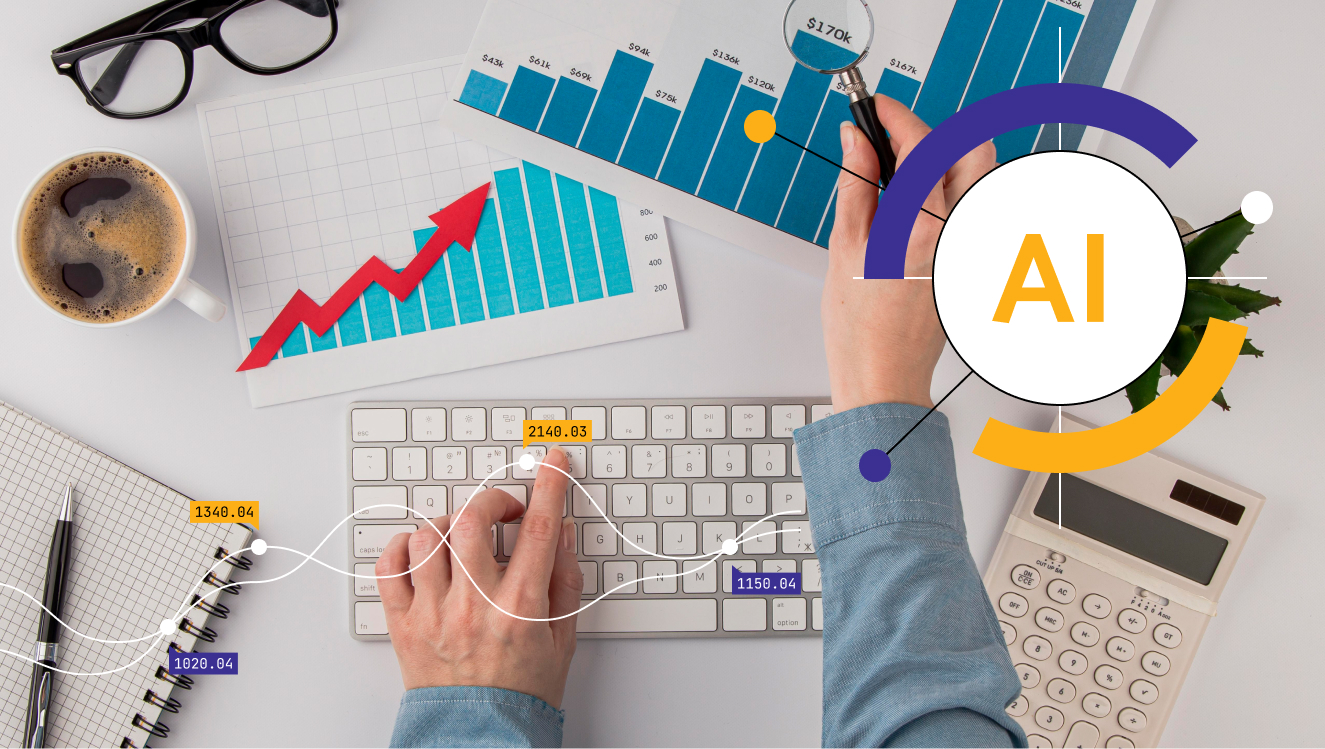Automating decision-making using AI
The article elucidates if AI can make decisions and where it can be used. AI-assisted decision-making comes with its challenges, which are listed here along with excerpts from our data scientists.

Jagadeesan
May 2, 2024
|7 mins

How does AI help in decision-making?
By analyzing a large dataset, AI can uncover patterns humans can’t see, offer inferences, and help humans make accurate decisions. This may or may not involve human oversight which depends on the process and the use case. And this AI decision-making can be in three forms.
A stand-alone or embedded AI-based system offering decision-making support through data exploration and analytics.
Offering real-time recommendations or future predictions based on past and current data, augmenting human intelligence on tricky systems.
Automate decision-making using data, rules, and AI, especially for a repetitive, less complicated process.
Here’s one generic decision intelligence example. Let’s say an AI-based fraud alert system is identifying suspicious transactions. Depending on the given conditions and trained datasets, it can block transactions. But some instances could become false positives—passed down to analysts who review them and make the call. It’s like a co-pilot that can navigate you through uncertain pathways, alleviating your workload and bringing more clarity to the decision-making process.
Challenges in AI-based decision making
AI-based decision-making isn’t as easy as it sounds to get it right. Many businesses are bogged down in their AI attempts due to the following reasons.
Poor quality data
Any machine learning model requires data—lots of them—to be built and trained for use, let alone a decision-making model. But with poor-quality data, you can’t go far. This either means you have inadequate, erroneous, duplicated, ambiguous, or missing data.
It can be due to many reasons - human errors, inconsistent efforts, poorly integrated data architecture, abandoned data sources, etc. But, this only leads to a skewed or misrepresented understanding of your current scenario by the model.
Though there are solutions for a few quality issues like data standardization, cleansing, imputation, etc, some become serious bottlenecks. So, building a model with data quality issues can either take a long time or become impossible to move further.
Bias and fairness
AI and ML bias is a common problem ML practitioners face while deploying a model into the production environment. Bias signifies a model's misassumptions in understanding relationships between variables or predicted outcomes. This leads to poorly calibrated models that send out biased results in an unexplanatory way. This bias can be against gender, race, age, demographics, economic background, or other protected attributes.
The results can be disastrous as the predictions lead to unfair decisions (which happens in manual decision-making too). Example: The Amazon hiring algorithm showed bias against women candidates, selecting male candidates as the top applicants.
Bias happens due to wrong sampling or the absence of complete datasets. It could also be due to the statistical relationship that non-protected attributes might share with protected attributes even if the latter is hidden due to sensitivity.
Continuous monitoring before and after deployment is required to envisage and weed out any unfairness or bias in generated outputs.
These fairness issues also raise concerns about the ethical usage of the model and how accountable and transparent its outcomes can be.
Too much data
Any AI model is as good as the data you have. However, too much data can be more problematic than when you have too little data. While the amount of data required always depends on the kind of problem you solve, higher volumes of data are only required in some cases. It’s more about quality than quantity for decision-making models.
The model becomes overfitted when trained and fed with large datasets where it’s unable to generalize on data it’s not trained with, leading to results that are not considerate of the entire data. With the right team of data scientists, you could navigate this issue.
Look below for how our team overcomes the curse of dimensionality with clever feature engineering.
The curse of dimensionality is a classic case machine learning experts face when the dimensions (features) of data increase. Such instances can cause problems where the models cannot generalize data and lead to overfitting models.
To fix this problem, our scientists choose highly relevant features or transform the existing ones using mathematical techniques, based on their domain expertise. They also apply other machine learning techniques like dimensionality reduction or L1 or L2 regularization. These methods reduce the dimensionality of the datasets and help our team navigate problems like model overfitting.
Organizational challenges
Many organizations are still following the traditional, top-down approach where decisions flow from top to bottom, following a proper, unwritten protocol. In such cases, it can be challenging to shift to the new norm where departmental managers and end users must accept a decision-making model as their new coworker. This cultural shift can be rough to navigate through. What decisions should the model make or offer suggestions on? What decisions can be automized? How does the reviewing system work? How this new way of working can be made easy for everyone while everyone is clear about their responsibilities?
These questions must be addressed before getting started with a managerial or operational decision-making model.
It needs humans still in the picture
Many AI-based decision-making models cannot explain how it concluded results this way. While it can offer insights and recommendations on time, it still needs human presence to judge, justify, and make the final call.
Will businesses use AI to make informed decisions in the future?
The question shouldn’t be about the future but now. While we discuss this, many companies are progressing, processing decisions at greater speeds. HBR confirms that 80% of global enterprises are already using AI in some form in 2023, a monumental shift in five years when this number was only 10%. This percentage includes decision support systems too, which is steadily growing now.
One example of AI-based decision-making technology could be AI in medical diagnosis. The healthcare industry is employing AI to scan medical images and X-rays and determine the presence of tumors or any abnormalities. With inputs from AI models, aiding radiologists, and healthcare providers make faster decisions.
The examples can go on. But the crux is that AI already plays a role in operational-level decision-making - be it prescriptive forecasting or actionable finance recommendations.
But what about organizational-level decision-making? How would AI fit into the realm of experienced and established leadership practices?
The whys and hows of AI in business decision-making are as follows, especially at strategic and executive levels.
The modern business landscape requires complex and nuanced understanding and isn’t tolerant of trials and errors. Times aren’t simple anymore where CEOs and leaders can look into a few files, use their personal experience, and make the decision. Any wrong step can account for unsurmountable losses. So, leaders must be wary of too many factors—along with unprecedented challenges—when they think about long-term strategies. This is why AI experts look forward to a future where AI can help decision-makers with both strategic and operational decisions, empowering humans in the loop. The more the leaders are equipped with emerging AI technologies, the more they can get the load off their shoulders, automating cumbersome and mundane processes.
Some industries already use AI for decision-making
AI has made its mark in the following industries: automating business processes, running validations, and delivering critical insights.
Finance
One of the most popular AI-based decision-making tools for the finance sector is risk management and fraud prevention. armed with rule-based systems and ML algorithms, the finance industry is already shutting out possible fraudulent transactions and money laundering activities.
Credit risk assessment is another use case where AI and ML are used to determine applicants’ creditworthiness to maximize investments. Robo advisors are gaining momentum too, which assess the best investment options, tailor-made for each user. More AI use cases for the finance industry here.
Manufacturing
From productivity improvement to automated maintenance, the list becomes lengthy for manufacturers.
Take quality control using AI for example. Based on previously trained images and videos of the product, this system finds defective products and separates them.
Then there is predictive maintenance, enabling industries to improve the lifetime value of their machinery.
Transparent supply chain management, robotics, and factory automation are other ways AI is strengthening decision-making for manufacturing.
Healthcare
AI can be a reliable decision support system for healthcare professionals. Deep learning-based systems are able to diagnose diseases at the earliest and even suggest treatment plans.
It plays a crucial role in medical imaging and diagnosis by identifying tumors, anomalies, or any other irregularities by analyzing the MRI scans, X-ray images, and other CT scan reports. These AI models are trained with millions of medical images for precision in diagnosis. It can even share the stage and type of tumor or cancer, helping medical professionals come up with a timely conclusion for a speedy resolution.
AI also enhances rule-based expert systems that healthcare professionals use while making decisions. A simple rule would be if x = y, then proceed with z. But in the real world, rules are often complex to the extent that normal systems would break down while processing. Artificial intelligence empowers these rule-based systems to house an extended knowledge base along with a reasoning engine, generating inferences based on given inputs.
It’s highly hopeful for the healthcare industry leading to a future of shared decision-making where multiple clinical technicians and healthcare professionals can collaborate in real time for fast and accurate decisions.
Retail
Demand and sales forecasting, automatic pricing optimization, personalized targeting, segmentation, etc are a few where AI becomes a crucial element, leading to better decision-making. They help retailers make more profit, maintain ideal inventory levels, and share a great relationship with customers. More than all of these, AI helps retailers in making the right calls, from pricing a small product to stocking a whole range of them from vendors.
📖 Recommended read: AI in Retail
Importance of AI in decision-making and why it should be a priority
Make faster decision
This is a given. Using AI for decision-making is like having a personal assistant who is equipped with expert subject knowledge. It works great for small, everyday decisions that can stall other operational work if not made on time.
Eliminating time-consuming tasks
More than 30% of the time is spent on decision-making, agrees 54% of leaders from this McKinsey study. But not all decisions require a higher amount of time and energy. This is where you can harness AI and cross out time-consuming, hindrance-causing tasks from your to-do list faster.
No trend goes unnoticed
With the help of AI, humans can uncover hidden trends and patterns better. Combined with their subject-matter expertise, they could draw explainable inferences and strengthen their decision-making or apply that to real-time operations.
Mitigate risks
Skipping risks isn’t easy as it requires analyzing a scenario from multiple angles. AI simplifies that for you, allowing you to mull over filtered information and make the final decision.
No place for human bias
Human errors and bias are unavoidable. Combining the power of AI with human intelligence can lead to error-free decisions that benefit your business.
Accurate forecasting
Retail, supply chain, and logistics units can rely on AI to predict changing demands accurately. These demands are influenced by many factors from geography to weather to economic trends. AI-based forecasting is an effective way to tackle this, maximizing revenue and minimizing spending.
Final thoughts
The dominance of AI in the decision-making process is steadily progressing, thanks to innovations and customizations in AI use cases. We will soon be in a business environment where decisions are made heuristically as if one is flipping pages of a book. Decision support systems will be embedded in most parts of our work systems and be seen as a reliable coworker. Businesses will generate value-adding insights on auto-pilot, without taking the human element from the picture.
Achieve your business goals with AI
Contact us

